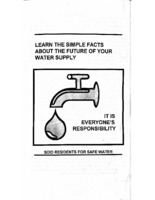Dioxane Discovered from Gelman Sciences
In 1984, the discovery of a carcinogen, 1,4-dioxane, in southwest Ann Arbor sparked what would become an ongoing and hotly contested battle for environmental justice. As a synthetic industrial solvent that is soluble in water and resistant to biodegradation, 1,4-dioxane had the potential to infiltrate water supplies through the natural flows of groundwater. The source of the pollution was Gelman Sciences, a manufacturer of industrial filters designed to detect, among other things, water pollution.
When faced with mitigating the presence of 1,4-dioxane, the company’s CEO, Charles Gelman, launched a series of legal campaigns and frantically denied the “polluter” label. When Gelman’s legal campaigns failed, the CEO resorted to harassment campaigns that targeted a variety of groups, from the Michigan Department of Natural Resources, to the Ecology Center staff. In 2019, years after the shut-down of Gelman Sciences, the core pollution site near Scio Township remains contaminated with 1,4-dioxane despite some small legal victories that mandated cleanup in the 1990s.
Background to the Gelman Pollution Case
The story of the pollution at the Gelman site began when the ambitious businessman, Chuck Gelman, started his microfilters manufacturing company in Ann Arbor during the early 1960s. Gelman, a graduate of the University of Michigan School of Public Health, received a permit from the Michigan Water Resources Commission to discharge manufacturing waste to an on-site sewage lagoon in 1977. Though the permit established some restrictions on what could be stored in the lagoon, it did not regulate 1,4-dioxane, revealing the limitations of contemporary science and carcinogens.
In 1984, a graduate student at the U-M Department of Environmental and Industrial Health by the name of Daniel Bicknell conducted a sampling study on Third Sister Lake, which neighbored the Gelman Sciences manufacturing plant. His results revealed excessive amounts of 1,4-dioxane and this discovery started a saga of regulation battles between the state's Department of Natural Resources and Gelman Sciences. Insisting on the legality of his previous permit, Gelman initially refused to defray clean-up costs. He instead began a series of back-and-forth lawsuits with the DNR and Scio Township. Residents of the township had largely stopped drinking local water by 1965 and were instead supplied with water bottles by the city. In 1988, the DNR named Gelman Sciences the second worst polluter in Michigan. Gelman responded with a lawsuit, which Gelman won, forcing the DNR to change its standards for defining polluters. This reclassification brought Gelman Sciences down to 11th place.
After public uproar, Gelman began to look for the cheapest and easiest methods to resolve the clean-up issue at the expense of an effective, environmentally cautious clean-up. In 1986, the Environmental Protection Agency granted Gelman a permit to inject the contaminated water into the ground through a deep well. Citizens rallied and petitioned against the proposed disposal, demonstrating heightened public awareness about the contamination problem.
In 1991, courts ruled that city the liable for clean-up costs, a decision described by the Ann Arbor News as “tantamount to a license to pollute.” Additionally, Michigan's DNR faced significant downscaling and restructuring with the election of John Engler as governor. In effect, the responsibility to clean-up the pollution site gradually fell on the victims instead of the polluters themselves. The citizens of Scio and Ann Arbor had to mobilize to hold Gelman Sciences accountable.



